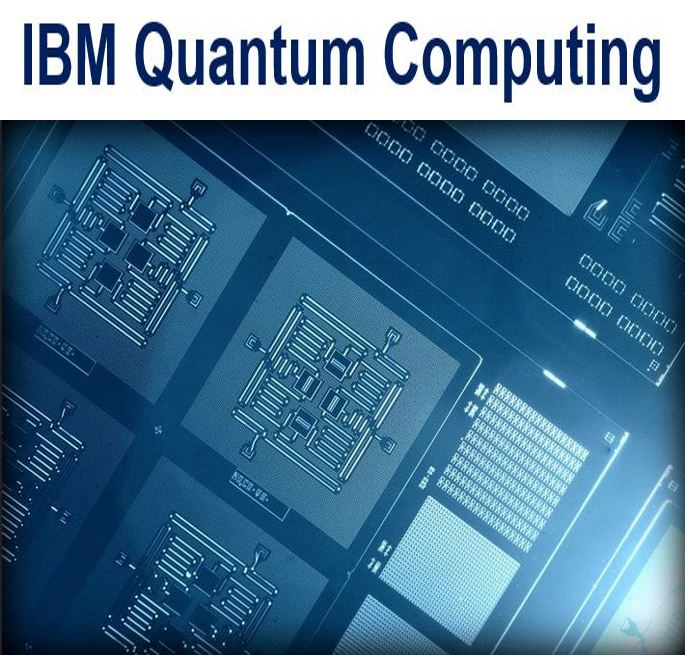IBM is a step closer towards creating a practical quantum computer, company scientists announced on Wednesday. A quantum computer computes using superpositions of quantum states – it can solve problems much faster than any conventional computer.
For the first time, the researchers showed the ability to detect and measure both types of quantum errors simultaneously, as well demonstrating a new, square quantum bit circuit design “that is the only physical architecture that could successfully scale to larger dimensions.”
With Moore’s Law – Intel’s co-founder Gordon E. Moore’s prediction that the number of transistors per square inch on integrated circuits would double every two years since 1975 – running out of steam, quantum computing will be one of the new inventions that may introduce a new era of innovation across industries.

Layout for IBM Four Qubit Square Circuit. Using a square lattice, the company is able to detect both types of quantum errors for the first time. This is the best configuration to add more qubits to scale to larger systems. (Credit: IBM Research)
A quantum computer would vastly outperform any current computer
Quantum computers could open up new capabilities in the fields of optimization and simulation that are simply impossible using today’s computers. If researchers could build a quantum computer with just 50 qubits (quantum bits), no combination of the TOP500 supercomputers today could successfully outperform it.
A.D. Córcoles, Easwar Magesan, Srikanth J. Srinivasan, Andrew W. Cross, M. Steffen, Jay M. Gambetta and Jerry M. Chow, who work at the IBM T.J. Watson Research Center, Yorktown Heights, New York, wrote about their breakthrough in the academic journal Nature Communications (citation below).
The authors claim to show for the first time the ability to detect and measure bit-flip and phase-flip – two types of quantum errors that will occur in any real quantum computer.
It had only been possible to address one type of quantum error at any one time. To be able to address both simultaneously is a necessary step toward quantum error correction, which is a vital requirement for creating a practical and reliable large-scale quantum computer.
New quantum bit circuit
IBM’s new and complex quantum bit circuit, based on a square lattice of 4 superconducting qubits on a chip approximately one-quarter-inch square, enables the two types of quantum errors to be detected simultaneously.
By opting for a square-shaped design rather than a linear array – which prevents the detection of the two kinds of quantum errors at the same time – IBM’s design “shows the best potential to scale by adding more qubits to arrive at a working quantum system.”
Arvind Krishna, senior vice president and director of IBM Research, said:
“Quantum computing could be potentially transformative, enabling us to solve problems that are impossible or impractical to solve today.”
“While quantum computers have traditionally been explored for cryptography, one area we find very compelling is the potential for practical quantum systems to solve problems in physics and quantum chemistry that are unsolvable today.”
“This could have enormous potential in materials or drug design, opening up a new realm of applications.”

Quantum computing will allow us to solve problems that are impossible to do today, says Mr. Krishna. (Image: ibmsystemsmag.com)
Quantum computing would speed up rate of innovations
For example, in chemistry and physics, quantum computing would allow researchers to design new materials and drug molecules without costly trial and error trials in the lab, potentially speeding up the rate of innovations across a range of different industries.
For a world where Big Data is king, quantum computers could rapidly sort and curate ever-growing databases as well as huge stores of diverse, unstructured data.
This could completely transform how people make decisions and how scientists across industries make critical discoveries.
One of the greatest problems for scientists seeking to harness quantum computing’s power is controlling or removing quantum decoherence – the creation of errors in calculations due to interference from factors such as material defects, electromagnetic radiation and heat. The errors are especially marked in quantum machines, given that quantum data are so fragile.
Co-author, Jay Gambetta, a manager in the IBM Quantum Computing Group, said:
“Up until now, researchers have been able to detect bit-flip or phase-flip quantum errors, but never the two together.”
“Previous work in this area, using linear arrangements, only looked at bit-flip errors offering incomplete information on the quantum state of a system and making them inadequate for a quantum computer.”
“Our four qubit results take us past this hurdle by detecting both types of quantum errors and can be scalable to larger systems, as the qubits are arranged in a square lattice as opposed to a linear array.”
The research at IBM was partly funded by the Intelligence Advanced Research Projects Activity (IARPA), a US research agency under the Director of National Intelligence’s responsibility.
Detecting quantum errors
The most basic datum (piece of data) that a typical computer understands is a bit. A bit, much like a beam of light that is either switched on or off, can only have two values: ‘1’ or ‘0’.
A qubit (quantum bit), however, can hold values ‘1’ or ‘0’, but also both values simultaneously, described as superposition and simply denoted as ‘0+1’.
IBM writes:
“The sign of this superposition is important because both states 0 and 1 have a phase relationship to each other. This superposition property is what allows quantum computers to choose the correct solution amongst millions of possibilities in a time much faster than a conventional computer.”
In such a superposition state, two types of errors are possible. One type, called a bit-flip error, occurs when a ‘0’ or ‘1’ is flipped, and vice-versa. This is similar to classical bit-flip errors, and previous studies have shown how to detect these errors on qubits.
Quantum error correction must detect both types of errors
However, this is not enough for quantum error correction, because phase-flip errors may also be present, which flip the sign of the pase relationship between ‘0’ and ‘1’ in a superposition state. For quantum error correction to function properly, both types of errors must be detected.
Quantum information is extremely fragile, because all existing qubit technologies lose their data when interacting with electromagnetic radiation and matter.
Theorists have devised ways to preserve the data much longer by spreading information across several physical qubits. The technical name for a specific error correction scheme that spreads quantum data across many qubits is ‘surface code’.
Surface code allows for only the nearest neighbour interactions to encode one logical qubit, making it stable enough to perform error-free operations.
The IBM scientists used several techniques to measure the state of two independent syndrome (measurement) qubits. Each one reveals one aspect of the quantum data stored on two other qubits (called code or data qubits).
The scientists wrote:
“Specifically, one syndrome qubit revealed whether a bit-flip error occurred to either of the code qubits, while the other syndrome qubit revealed whether a phase-flip error occurred.”
“Determining the joint quantum information in the code qubits is an essential step for quantum error correction because directly measuring the code qubits destroys the information contained within them.”
As these qubits can be designed and manufactured using standard silicon fabrication techniques, IBM predicts that once a handful of superconducting qubits can be reliably and repeatedly manufactured, and controlled with low error rates, there will be no fundamental obstacle to demonstrating error correction in larger qubit lattices.
IBM wrote:
“These results highlight IBM’s long commitment to quantum information processing that has spanned more than 30 years, beginning with IBM’s participation in the very first workshop in this field on the Physics of Information in 1981.”
You can read more about the new era of quantum computing research at A Smarter Planet blog.
Citation: “Demonstration of a quantum error detection code using a square lattice of four superconducting qubits,” Andrew W. Cross, A.D. Córcoles,M. Steffen, Easwar Magesan, Srikanth J. Srinivasan, Jay M. Gambetta & Jerry M. Chow. Nature Communications. Published 29 April, 2015. DOI: 10.1038/ncomms7979.
IBM Video – Golden Age of Quantum Computing Research
In this IBM video, members of the company’s quantum computing teams talk about their hopes for progress in quantum computing and detail their latest experiments.
